Hybrid Solar-Wind Renewable Energy Systems in Remote Australia Project
VerifiedAdded on 2023/03/29
|42
|8731
|407
Project
AI Summary
This project report examines hybrid solar-wind renewable energy systems, specifically focusing on their application in remote areas of Australia. The study begins with a comprehensive literature review, covering photovoltaic solar systems, wind energy technologies, and the integration of wind-solar hybrid power systems. The methodology section details the component modeling of the system, including solar PV arrays, wind turbine generators, and battery storage, along with the modeling of energy demand. An optimal sizing algorithm is developed, considering both reliability and cost objectives, and boundary conditions. The results of the modeling and optimization are presented, followed by an analysis of the system's performance and the factors influencing its effectiveness. The project concludes with a discussion of the potential of hybrid renewable energy systems to provide sustainable and cost-effective power solutions in remote Australian communities, addressing the challenges of electricity supply in sparsely populated regions and the benefits of reducing reliance on conventional energy sources.
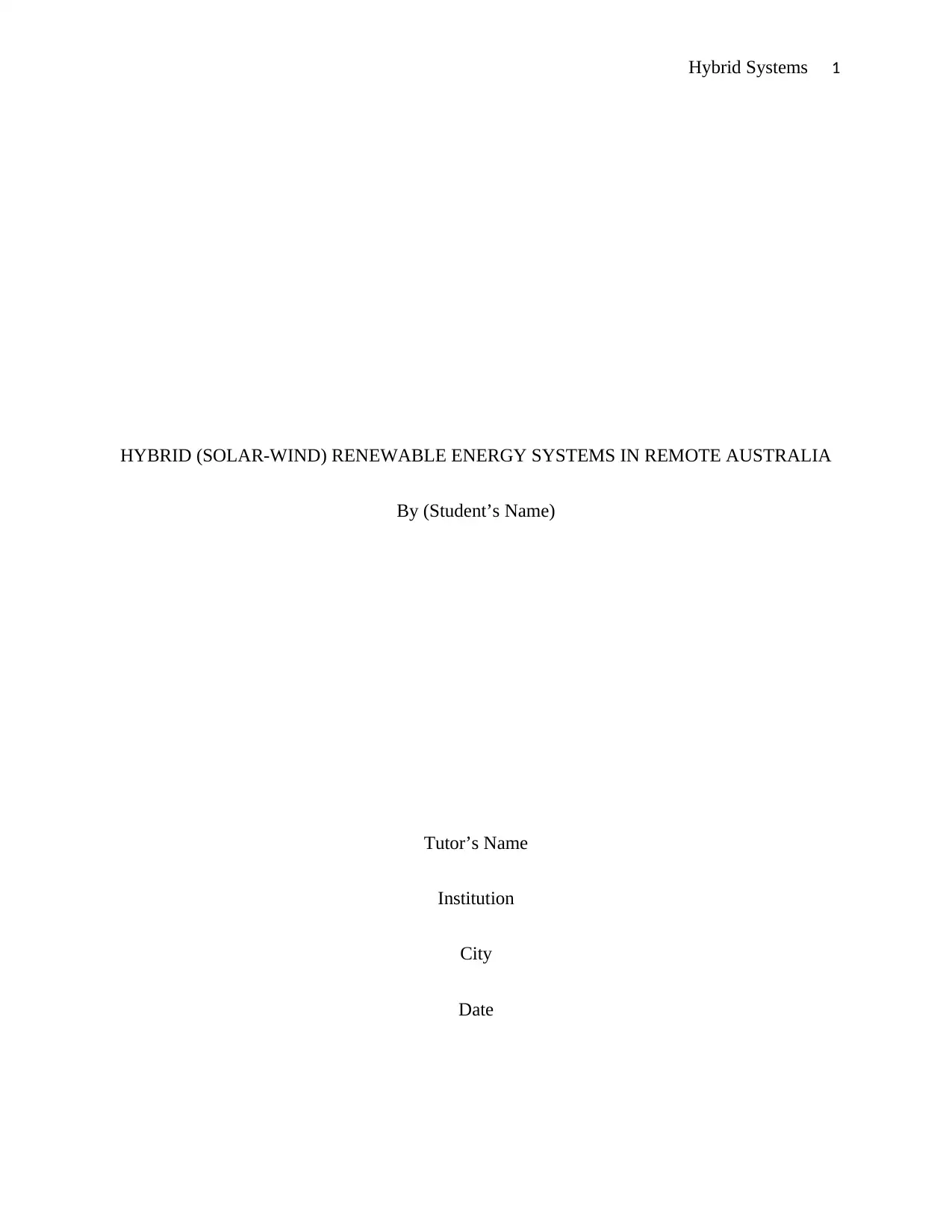
Hybrid Systems 1
HYBRID (SOLAR-WIND) RENEWABLE ENERGY SYSTEMS IN REMOTE AUSTRALIA
By (Student’s Name)
Tutor’s Name
Institution
City
Date
HYBRID (SOLAR-WIND) RENEWABLE ENERGY SYSTEMS IN REMOTE AUSTRALIA
By (Student’s Name)
Tutor’s Name
Institution
City
Date
Paraphrase This Document
Need a fresh take? Get an instant paraphrase of this document with our AI Paraphraser
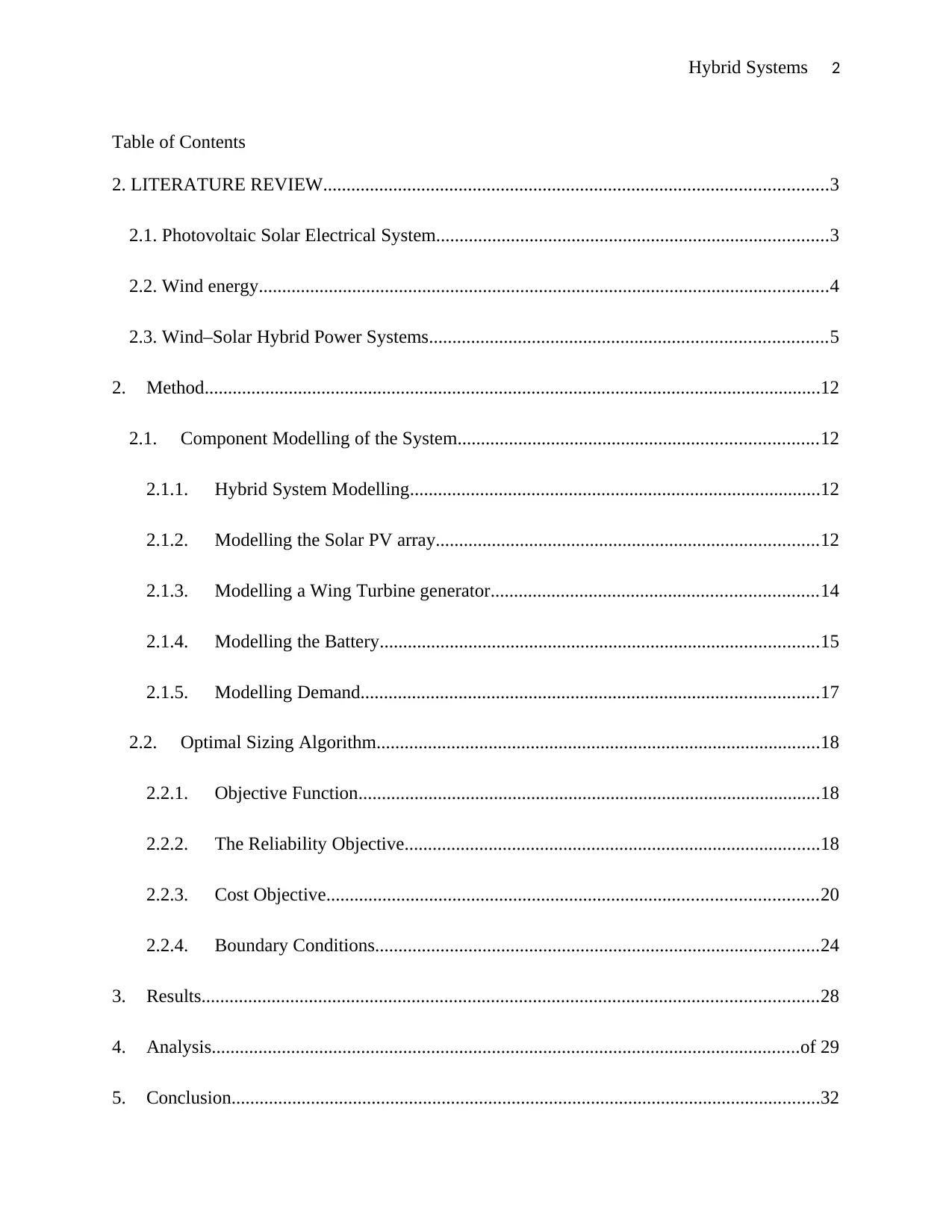
Hybrid Systems 2
Table of Contents
2. LITERATURE REVIEW............................................................................................................3
2.1. Photovoltaic Solar Electrical System....................................................................................3
2.2. Wind energy..........................................................................................................................4
2.3. Wind–Solar Hybrid Power Systems.....................................................................................5
2. Method....................................................................................................................................12
2.1. Component Modelling of the System.............................................................................12
2.1.1. Hybrid System Modelling........................................................................................12
2.1.2. Modelling the Solar PV array..................................................................................12
2.1.3. Modelling a Wing Turbine generator......................................................................14
2.1.4. Modelling the Battery..............................................................................................15
2.1.5. Modelling Demand..................................................................................................17
2.2. Optimal Sizing Algorithm...............................................................................................18
2.2.1. Objective Function...................................................................................................18
2.2.2. The Reliability Objective.........................................................................................18
2.2.3. Cost Objective.........................................................................................................20
2.2.4. Boundary Conditions...............................................................................................24
3. Results....................................................................................................................................28
4. Analysis..............................................................................................................................of 29
5. Conclusion..............................................................................................................................32
Table of Contents
2. LITERATURE REVIEW............................................................................................................3
2.1. Photovoltaic Solar Electrical System....................................................................................3
2.2. Wind energy..........................................................................................................................4
2.3. Wind–Solar Hybrid Power Systems.....................................................................................5
2. Method....................................................................................................................................12
2.1. Component Modelling of the System.............................................................................12
2.1.1. Hybrid System Modelling........................................................................................12
2.1.2. Modelling the Solar PV array..................................................................................12
2.1.3. Modelling a Wing Turbine generator......................................................................14
2.1.4. Modelling the Battery..............................................................................................15
2.1.5. Modelling Demand..................................................................................................17
2.2. Optimal Sizing Algorithm...............................................................................................18
2.2.1. Objective Function...................................................................................................18
2.2.2. The Reliability Objective.........................................................................................18
2.2.3. Cost Objective.........................................................................................................20
2.2.4. Boundary Conditions...............................................................................................24
3. Results....................................................................................................................................28
4. Analysis..............................................................................................................................of 29
5. Conclusion..............................................................................................................................32

Hybrid Systems 3
6. References..............................................................................................................................35
6. References..............................................................................................................................35
⊘ This is a preview!⊘
Do you want full access?
Subscribe today to unlock all pages.

Trusted by 1+ million students worldwide
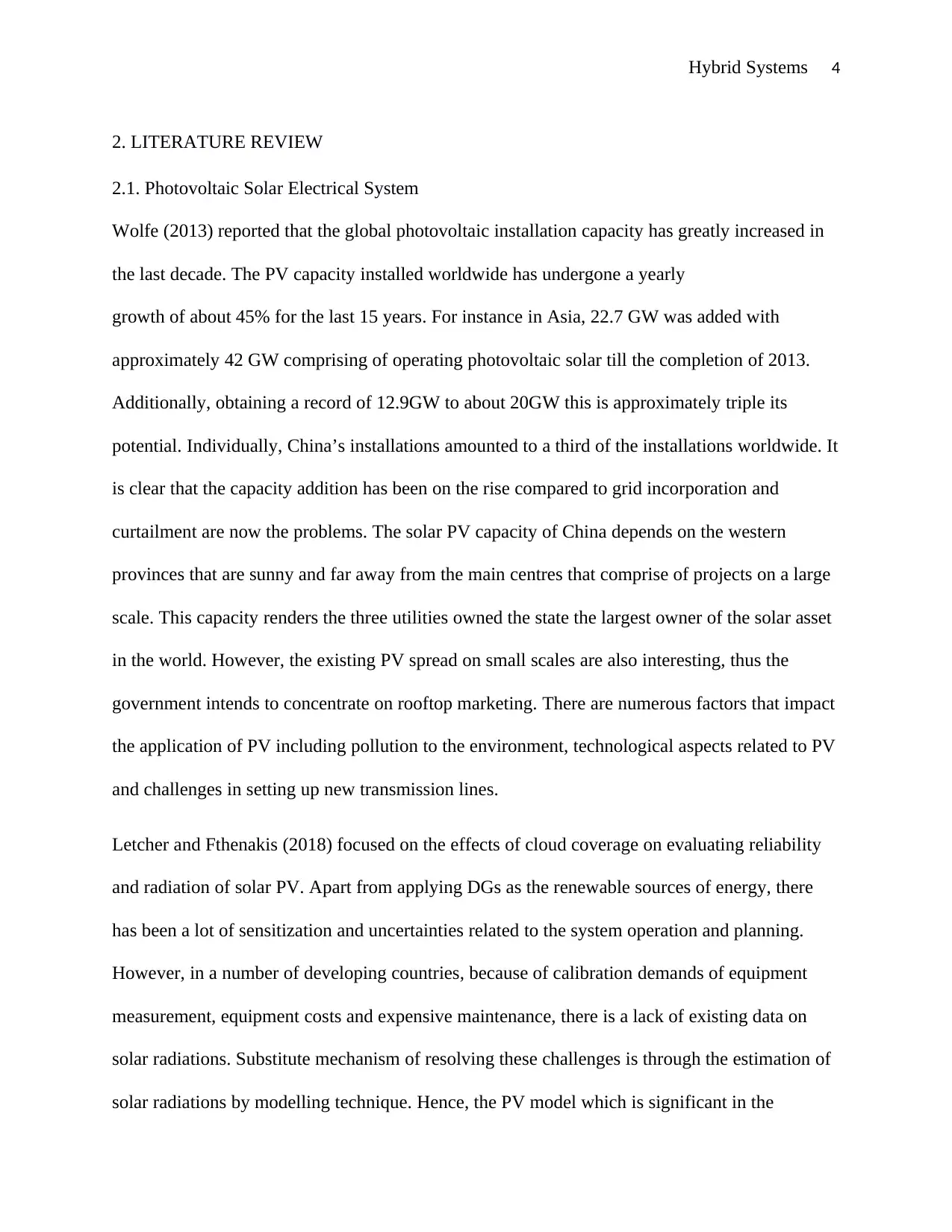
Hybrid Systems 4
2. LITERATURE REVIEW
2.1. Photovoltaic Solar Electrical System
Wolfe (2013) reported that the global photovoltaic installation capacity has greatly increased in
the last decade. The PV capacity installed worldwide has undergone a yearly
growth of about 45% for the last 15 years. For instance in Asia, 22.7 GW was added with
approximately 42 GW comprising of operating photovoltaic solar till the completion of 2013.
Additionally, obtaining a record of 12.9GW to about 20GW this is approximately triple its
potential. Individually, China’s installations amounted to a third of the installations worldwide. It
is clear that the capacity addition has been on the rise compared to grid incorporation and
curtailment are now the problems. The solar PV capacity of China depends on the western
provinces that are sunny and far away from the main centres that comprise of projects on a large
scale. This capacity renders the three utilities owned the state the largest owner of the solar asset
in the world. However, the existing PV spread on small scales are also interesting, thus the
government intends to concentrate on rooftop marketing. There are numerous factors that impact
the application of PV including pollution to the environment, technological aspects related to PV
and challenges in setting up new transmission lines.
Letcher and Fthenakis (2018) focused on the effects of cloud coverage on evaluating reliability
and radiation of solar PV. Apart from applying DGs as the renewable sources of energy, there
has been a lot of sensitization and uncertainties related to the system operation and planning.
However, in a number of developing countries, because of calibration demands of equipment
measurement, equipment costs and expensive maintenance, there is a lack of existing data on
solar radiations. Substitute mechanism of resolving these challenges is through the estimation of
solar radiations by modelling technique. Hence, the PV model which is significant in the
2. LITERATURE REVIEW
2.1. Photovoltaic Solar Electrical System
Wolfe (2013) reported that the global photovoltaic installation capacity has greatly increased in
the last decade. The PV capacity installed worldwide has undergone a yearly
growth of about 45% for the last 15 years. For instance in Asia, 22.7 GW was added with
approximately 42 GW comprising of operating photovoltaic solar till the completion of 2013.
Additionally, obtaining a record of 12.9GW to about 20GW this is approximately triple its
potential. Individually, China’s installations amounted to a third of the installations worldwide. It
is clear that the capacity addition has been on the rise compared to grid incorporation and
curtailment are now the problems. The solar PV capacity of China depends on the western
provinces that are sunny and far away from the main centres that comprise of projects on a large
scale. This capacity renders the three utilities owned the state the largest owner of the solar asset
in the world. However, the existing PV spread on small scales are also interesting, thus the
government intends to concentrate on rooftop marketing. There are numerous factors that impact
the application of PV including pollution to the environment, technological aspects related to PV
and challenges in setting up new transmission lines.
Letcher and Fthenakis (2018) focused on the effects of cloud coverage on evaluating reliability
and radiation of solar PV. Apart from applying DGs as the renewable sources of energy, there
has been a lot of sensitization and uncertainties related to the system operation and planning.
However, in a number of developing countries, because of calibration demands of equipment
measurement, equipment costs and expensive maintenance, there is a lack of existing data on
solar radiations. Substitute mechanism of resolving these challenges is through the estimation of
solar radiations by modelling technique. Hence, the PV model which is significant in the
Paraphrase This Document
Need a fresh take? Get an instant paraphrase of this document with our AI Paraphraser
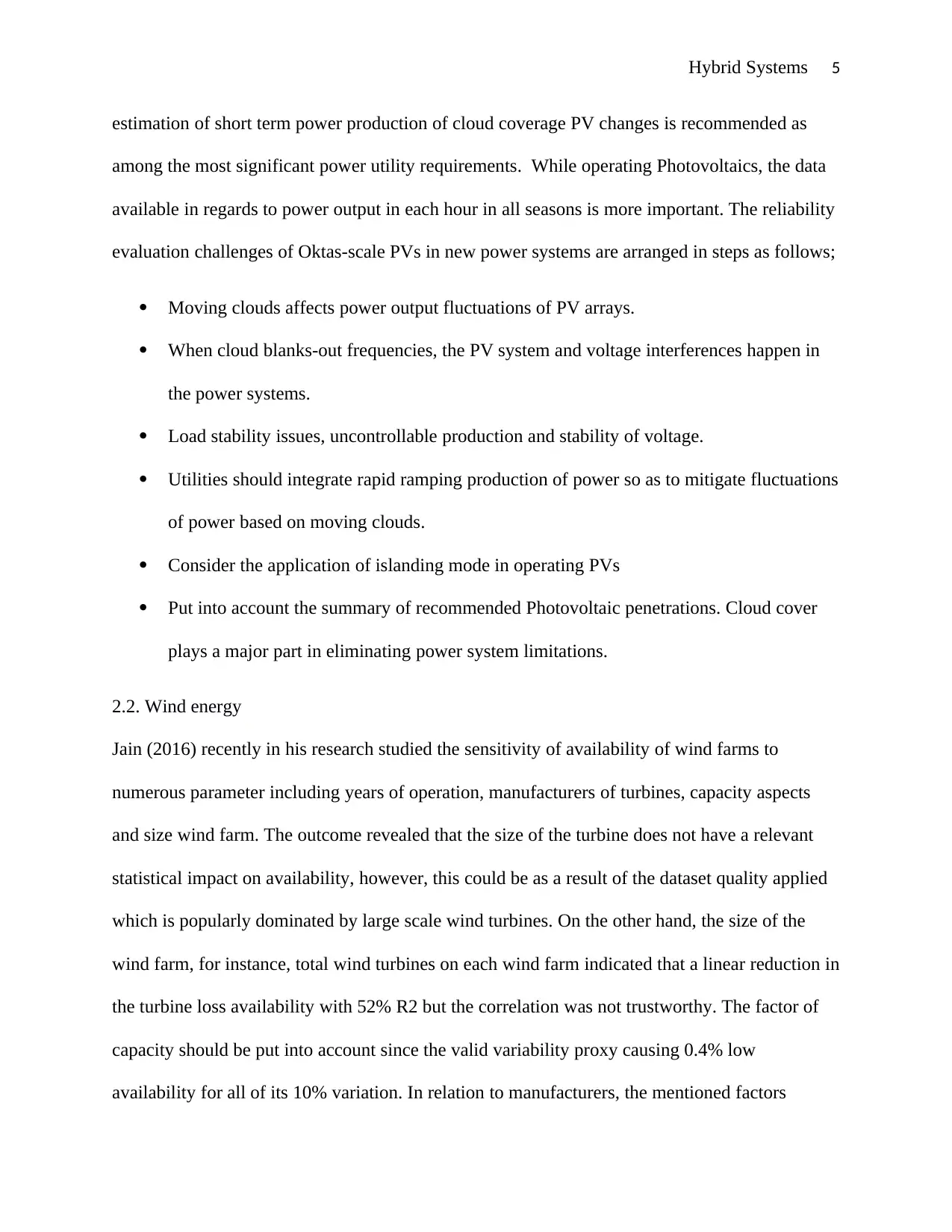
Hybrid Systems 5
estimation of short term power production of cloud coverage PV changes is recommended as
among the most significant power utility requirements. While operating Photovoltaics, the data
available in regards to power output in each hour in all seasons is more important. The reliability
evaluation challenges of Oktas-scale PVs in new power systems are arranged in steps as follows;
Moving clouds affects power output fluctuations of PV arrays.
When cloud blanks-out frequencies, the PV system and voltage interferences happen in
the power systems.
Load stability issues, uncontrollable production and stability of voltage.
Utilities should integrate rapid ramping production of power so as to mitigate fluctuations
of power based on moving clouds.
Consider the application of islanding mode in operating PVs
Put into account the summary of recommended Photovoltaic penetrations. Cloud cover
plays a major part in eliminating power system limitations.
2.2. Wind energy
Jain (2016) recently in his research studied the sensitivity of availability of wind farms to
numerous parameter including years of operation, manufacturers of turbines, capacity aspects
and size wind farm. The outcome revealed that the size of the turbine does not have a relevant
statistical impact on availability, however, this could be as a result of the dataset quality applied
which is popularly dominated by large scale wind turbines. On the other hand, the size of the
wind farm, for instance, total wind turbines on each wind farm indicated that a linear reduction in
the turbine loss availability with 52% R2 but the correlation was not trustworthy. The factor of
capacity should be put into account since the valid variability proxy causing 0.4% low
availability for all of its 10% variation. In relation to manufacturers, the mentioned factors
estimation of short term power production of cloud coverage PV changes is recommended as
among the most significant power utility requirements. While operating Photovoltaics, the data
available in regards to power output in each hour in all seasons is more important. The reliability
evaluation challenges of Oktas-scale PVs in new power systems are arranged in steps as follows;
Moving clouds affects power output fluctuations of PV arrays.
When cloud blanks-out frequencies, the PV system and voltage interferences happen in
the power systems.
Load stability issues, uncontrollable production and stability of voltage.
Utilities should integrate rapid ramping production of power so as to mitigate fluctuations
of power based on moving clouds.
Consider the application of islanding mode in operating PVs
Put into account the summary of recommended Photovoltaic penetrations. Cloud cover
plays a major part in eliminating power system limitations.
2.2. Wind energy
Jain (2016) recently in his research studied the sensitivity of availability of wind farms to
numerous parameter including years of operation, manufacturers of turbines, capacity aspects
and size wind farm. The outcome revealed that the size of the turbine does not have a relevant
statistical impact on availability, however, this could be as a result of the dataset quality applied
which is popularly dominated by large scale wind turbines. On the other hand, the size of the
wind farm, for instance, total wind turbines on each wind farm indicated that a linear reduction in
the turbine loss availability with 52% R2 but the correlation was not trustworthy. The factor of
capacity should be put into account since the valid variability proxy causing 0.4% low
availability for all of its 10% variation. In relation to manufacturers, the mentioned factors
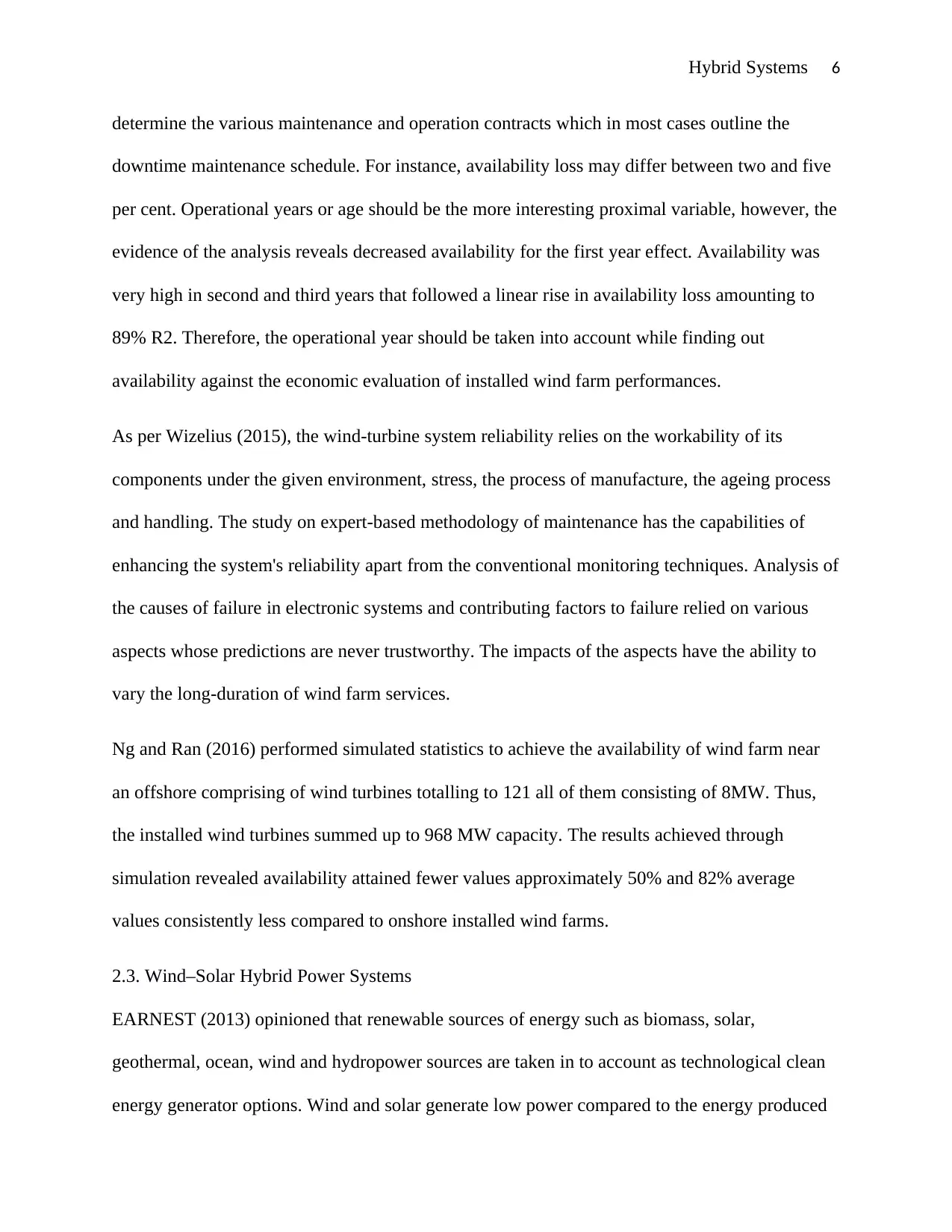
Hybrid Systems 6
determine the various maintenance and operation contracts which in most cases outline the
downtime maintenance schedule. For instance, availability loss may differ between two and five
per cent. Operational years or age should be the more interesting proximal variable, however, the
evidence of the analysis reveals decreased availability for the first year effect. Availability was
very high in second and third years that followed a linear rise in availability loss amounting to
89% R2. Therefore, the operational year should be taken into account while finding out
availability against the economic evaluation of installed wind farm performances.
As per Wizelius (2015), the wind-turbine system reliability relies on the workability of its
components under the given environment, stress, the process of manufacture, the ageing process
and handling. The study on expert-based methodology of maintenance has the capabilities of
enhancing the system's reliability apart from the conventional monitoring techniques. Analysis of
the causes of failure in electronic systems and contributing factors to failure relied on various
aspects whose predictions are never trustworthy. The impacts of the aspects have the ability to
vary the long-duration of wind farm services.
Ng and Ran (2016) performed simulated statistics to achieve the availability of wind farm near
an offshore comprising of wind turbines totalling to 121 all of them consisting of 8MW. Thus,
the installed wind turbines summed up to 968 MW capacity. The results achieved through
simulation revealed availability attained fewer values approximately 50% and 82% average
values consistently less compared to onshore installed wind farms.
2.3. Wind–Solar Hybrid Power Systems
EARNEST (2013) opinioned that renewable sources of energy such as biomass, solar,
geothermal, ocean, wind and hydropower sources are taken in to account as technological clean
energy generator options. Wind and solar generate low power compared to the energy produced
determine the various maintenance and operation contracts which in most cases outline the
downtime maintenance schedule. For instance, availability loss may differ between two and five
per cent. Operational years or age should be the more interesting proximal variable, however, the
evidence of the analysis reveals decreased availability for the first year effect. Availability was
very high in second and third years that followed a linear rise in availability loss amounting to
89% R2. Therefore, the operational year should be taken into account while finding out
availability against the economic evaluation of installed wind farm performances.
As per Wizelius (2015), the wind-turbine system reliability relies on the workability of its
components under the given environment, stress, the process of manufacture, the ageing process
and handling. The study on expert-based methodology of maintenance has the capabilities of
enhancing the system's reliability apart from the conventional monitoring techniques. Analysis of
the causes of failure in electronic systems and contributing factors to failure relied on various
aspects whose predictions are never trustworthy. The impacts of the aspects have the ability to
vary the long-duration of wind farm services.
Ng and Ran (2016) performed simulated statistics to achieve the availability of wind farm near
an offshore comprising of wind turbines totalling to 121 all of them consisting of 8MW. Thus,
the installed wind turbines summed up to 968 MW capacity. The results achieved through
simulation revealed availability attained fewer values approximately 50% and 82% average
values consistently less compared to onshore installed wind farms.
2.3. Wind–Solar Hybrid Power Systems
EARNEST (2013) opinioned that renewable sources of energy such as biomass, solar,
geothermal, ocean, wind and hydropower sources are taken in to account as technological clean
energy generator options. Wind and solar generate low power compared to the energy produced
⊘ This is a preview!⊘
Do you want full access?
Subscribe today to unlock all pages.

Trusted by 1+ million students worldwide
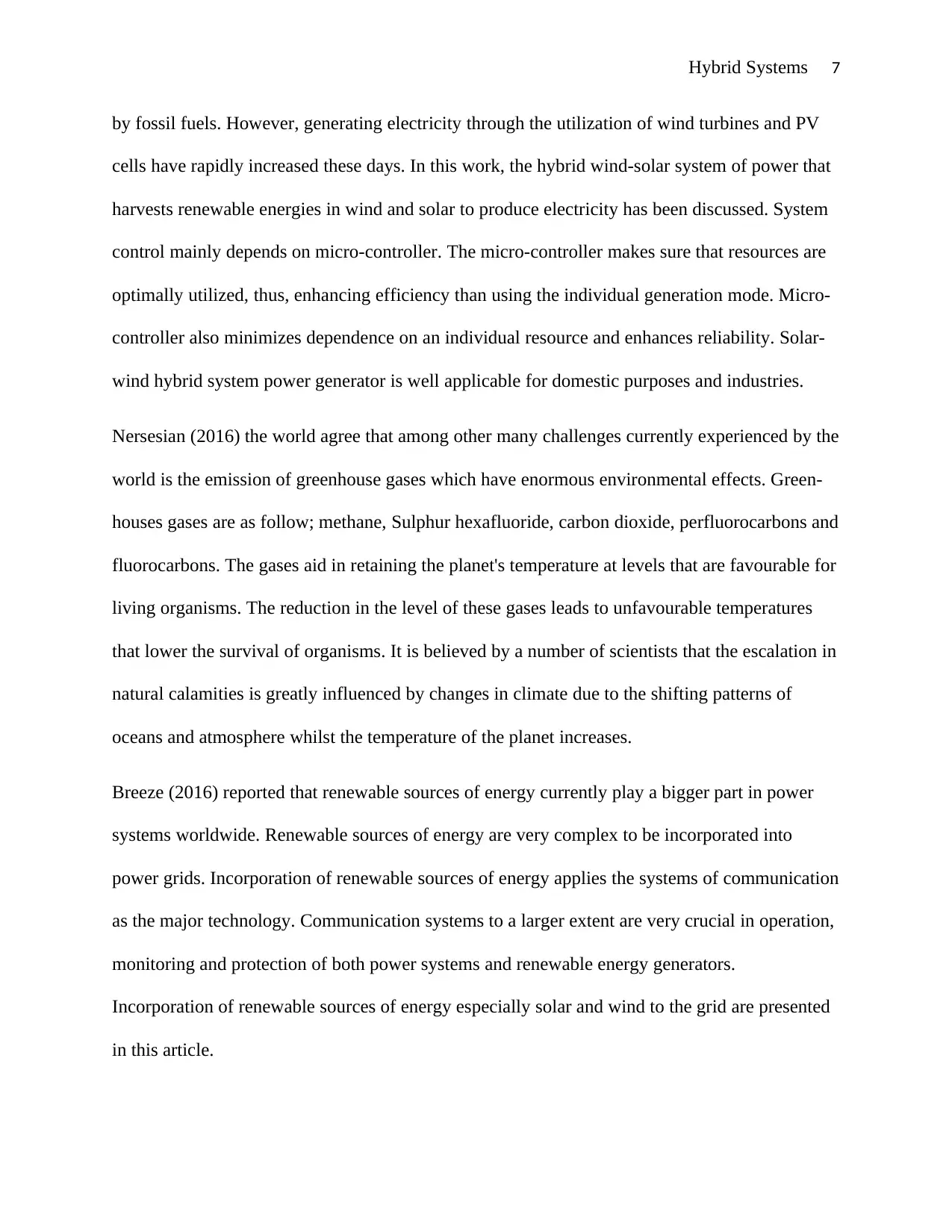
Hybrid Systems 7
by fossil fuels. However, generating electricity through the utilization of wind turbines and PV
cells have rapidly increased these days. In this work, the hybrid wind-solar system of power that
harvests renewable energies in wind and solar to produce electricity has been discussed. System
control mainly depends on micro-controller. The micro-controller makes sure that resources are
optimally utilized, thus, enhancing efficiency than using the individual generation mode. Micro-
controller also minimizes dependence on an individual resource and enhances reliability. Solar-
wind hybrid system power generator is well applicable for domestic purposes and industries.
Nersesian (2016) the world agree that among other many challenges currently experienced by the
world is the emission of greenhouse gases which have enormous environmental effects. Green-
houses gases are as follow; methane, Sulphur hexafluoride, carbon dioxide, perfluorocarbons and
fluorocarbons. The gases aid in retaining the planet's temperature at levels that are favourable for
living organisms. The reduction in the level of these gases leads to unfavourable temperatures
that lower the survival of organisms. It is believed by a number of scientists that the escalation in
natural calamities is greatly influenced by changes in climate due to the shifting patterns of
oceans and atmosphere whilst the temperature of the planet increases.
Breeze (2016) reported that renewable sources of energy currently play a bigger part in power
systems worldwide. Renewable sources of energy are very complex to be incorporated into
power grids. Incorporation of renewable sources of energy applies the systems of communication
as the major technology. Communication systems to a larger extent are very crucial in operation,
monitoring and protection of both power systems and renewable energy generators.
Incorporation of renewable sources of energy especially solar and wind to the grid are presented
in this article.
by fossil fuels. However, generating electricity through the utilization of wind turbines and PV
cells have rapidly increased these days. In this work, the hybrid wind-solar system of power that
harvests renewable energies in wind and solar to produce electricity has been discussed. System
control mainly depends on micro-controller. The micro-controller makes sure that resources are
optimally utilized, thus, enhancing efficiency than using the individual generation mode. Micro-
controller also minimizes dependence on an individual resource and enhances reliability. Solar-
wind hybrid system power generator is well applicable for domestic purposes and industries.
Nersesian (2016) the world agree that among other many challenges currently experienced by the
world is the emission of greenhouse gases which have enormous environmental effects. Green-
houses gases are as follow; methane, Sulphur hexafluoride, carbon dioxide, perfluorocarbons and
fluorocarbons. The gases aid in retaining the planet's temperature at levels that are favourable for
living organisms. The reduction in the level of these gases leads to unfavourable temperatures
that lower the survival of organisms. It is believed by a number of scientists that the escalation in
natural calamities is greatly influenced by changes in climate due to the shifting patterns of
oceans and atmosphere whilst the temperature of the planet increases.
Breeze (2016) reported that renewable sources of energy currently play a bigger part in power
systems worldwide. Renewable sources of energy are very complex to be incorporated into
power grids. Incorporation of renewable sources of energy applies the systems of communication
as the major technology. Communication systems to a larger extent are very crucial in operation,
monitoring and protection of both power systems and renewable energy generators.
Incorporation of renewable sources of energy especially solar and wind to the grid are presented
in this article.
Paraphrase This Document
Need a fresh take? Get an instant paraphrase of this document with our AI Paraphraser
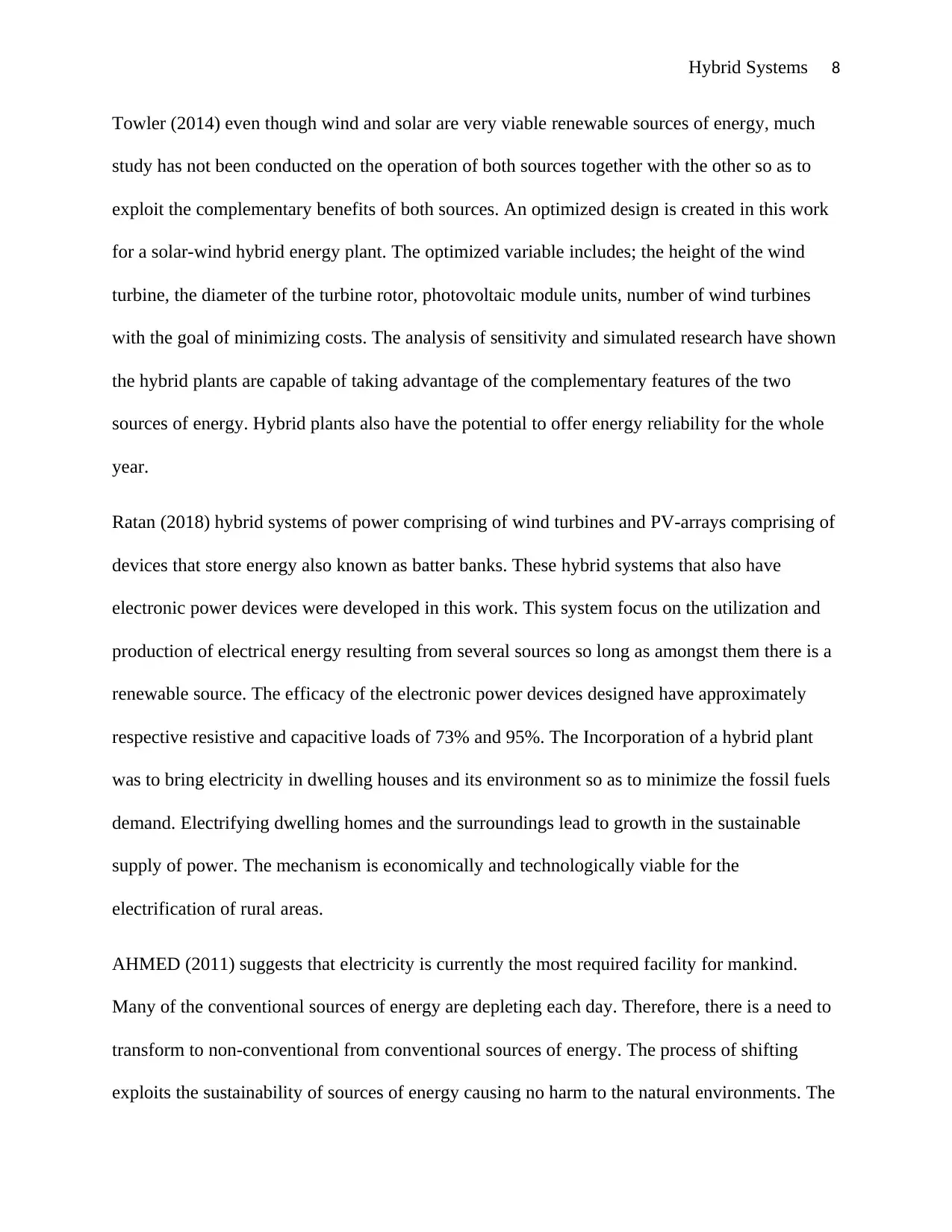
Hybrid Systems 8
Towler (2014) even though wind and solar are very viable renewable sources of energy, much
study has not been conducted on the operation of both sources together with the other so as to
exploit the complementary benefits of both sources. An optimized design is created in this work
for a solar-wind hybrid energy plant. The optimized variable includes; the height of the wind
turbine, the diameter of the turbine rotor, photovoltaic module units, number of wind turbines
with the goal of minimizing costs. The analysis of sensitivity and simulated research have shown
the hybrid plants are capable of taking advantage of the complementary features of the two
sources of energy. Hybrid plants also have the potential to offer energy reliability for the whole
year.
Ratan (2018) hybrid systems of power comprising of wind turbines and PV-arrays comprising of
devices that store energy also known as batter banks. These hybrid systems that also have
electronic power devices were developed in this work. This system focus on the utilization and
production of electrical energy resulting from several sources so long as amongst them there is a
renewable source. The efficacy of the electronic power devices designed have approximately
respective resistive and capacitive loads of 73% and 95%. The Incorporation of a hybrid plant
was to bring electricity in dwelling houses and its environment so as to minimize the fossil fuels
demand. Electrifying dwelling homes and the surroundings lead to growth in the sustainable
supply of power. The mechanism is economically and technologically viable for the
electrification of rural areas.
AHMED (2011) suggests that electricity is currently the most required facility for mankind.
Many of the conventional sources of energy are depleting each day. Therefore, there is a need to
transform to non-conventional from conventional sources of energy. The process of shifting
exploits the sustainability of sources of energy causing no harm to the natural environments. The
Towler (2014) even though wind and solar are very viable renewable sources of energy, much
study has not been conducted on the operation of both sources together with the other so as to
exploit the complementary benefits of both sources. An optimized design is created in this work
for a solar-wind hybrid energy plant. The optimized variable includes; the height of the wind
turbine, the diameter of the turbine rotor, photovoltaic module units, number of wind turbines
with the goal of minimizing costs. The analysis of sensitivity and simulated research have shown
the hybrid plants are capable of taking advantage of the complementary features of the two
sources of energy. Hybrid plants also have the potential to offer energy reliability for the whole
year.
Ratan (2018) hybrid systems of power comprising of wind turbines and PV-arrays comprising of
devices that store energy also known as batter banks. These hybrid systems that also have
electronic power devices were developed in this work. This system focus on the utilization and
production of electrical energy resulting from several sources so long as amongst them there is a
renewable source. The efficacy of the electronic power devices designed have approximately
respective resistive and capacitive loads of 73% and 95%. The Incorporation of a hybrid plant
was to bring electricity in dwelling houses and its environment so as to minimize the fossil fuels
demand. Electrifying dwelling homes and the surroundings lead to growth in the sustainable
supply of power. The mechanism is economically and technologically viable for the
electrification of rural areas.
AHMED (2011) suggests that electricity is currently the most required facility for mankind.
Many of the conventional sources of energy are depleting each day. Therefore, there is a need to
transform to non-conventional from conventional sources of energy. The process of shifting
exploits the sustainability of sources of energy causing no harm to the natural environments. The
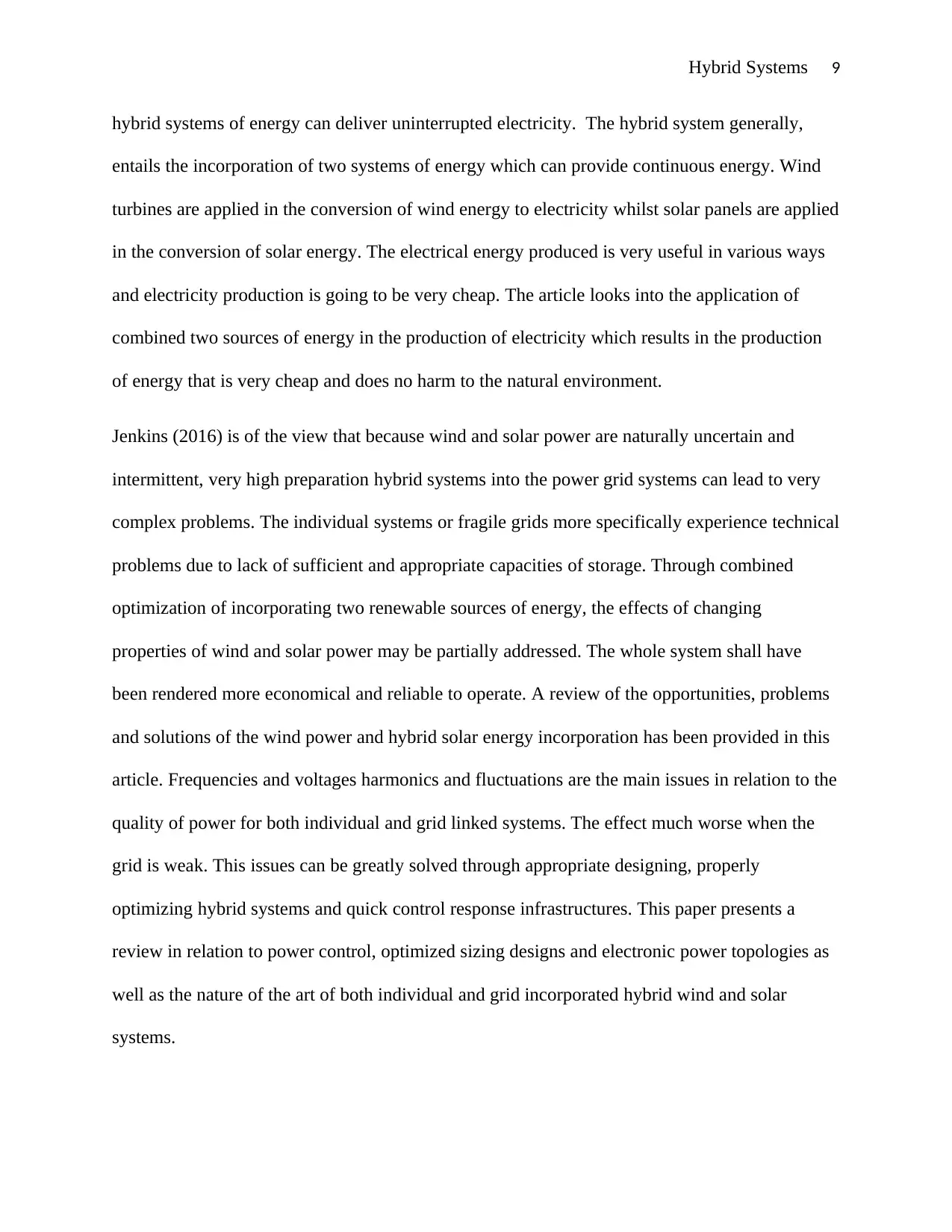
Hybrid Systems 9
hybrid systems of energy can deliver uninterrupted electricity. The hybrid system generally,
entails the incorporation of two systems of energy which can provide continuous energy. Wind
turbines are applied in the conversion of wind energy to electricity whilst solar panels are applied
in the conversion of solar energy. The electrical energy produced is very useful in various ways
and electricity production is going to be very cheap. The article looks into the application of
combined two sources of energy in the production of electricity which results in the production
of energy that is very cheap and does no harm to the natural environment.
Jenkins (2016) is of the view that because wind and solar power are naturally uncertain and
intermittent, very high preparation hybrid systems into the power grid systems can lead to very
complex problems. The individual systems or fragile grids more specifically experience technical
problems due to lack of sufficient and appropriate capacities of storage. Through combined
optimization of incorporating two renewable sources of energy, the effects of changing
properties of wind and solar power may be partially addressed. The whole system shall have
been rendered more economical and reliable to operate. A review of the opportunities, problems
and solutions of the wind power and hybrid solar energy incorporation has been provided in this
article. Frequencies and voltages harmonics and fluctuations are the main issues in relation to the
quality of power for both individual and grid linked systems. The effect much worse when the
grid is weak. This issues can be greatly solved through appropriate designing, properly
optimizing hybrid systems and quick control response infrastructures. This paper presents a
review in relation to power control, optimized sizing designs and electronic power topologies as
well as the nature of the art of both individual and grid incorporated hybrid wind and solar
systems.
hybrid systems of energy can deliver uninterrupted electricity. The hybrid system generally,
entails the incorporation of two systems of energy which can provide continuous energy. Wind
turbines are applied in the conversion of wind energy to electricity whilst solar panels are applied
in the conversion of solar energy. The electrical energy produced is very useful in various ways
and electricity production is going to be very cheap. The article looks into the application of
combined two sources of energy in the production of electricity which results in the production
of energy that is very cheap and does no harm to the natural environment.
Jenkins (2016) is of the view that because wind and solar power are naturally uncertain and
intermittent, very high preparation hybrid systems into the power grid systems can lead to very
complex problems. The individual systems or fragile grids more specifically experience technical
problems due to lack of sufficient and appropriate capacities of storage. Through combined
optimization of incorporating two renewable sources of energy, the effects of changing
properties of wind and solar power may be partially addressed. The whole system shall have
been rendered more economical and reliable to operate. A review of the opportunities, problems
and solutions of the wind power and hybrid solar energy incorporation has been provided in this
article. Frequencies and voltages harmonics and fluctuations are the main issues in relation to the
quality of power for both individual and grid linked systems. The effect much worse when the
grid is weak. This issues can be greatly solved through appropriate designing, properly
optimizing hybrid systems and quick control response infrastructures. This paper presents a
review in relation to power control, optimized sizing designs and electronic power topologies as
well as the nature of the art of both individual and grid incorporated hybrid wind and solar
systems.
⊘ This is a preview!⊘
Do you want full access?
Subscribe today to unlock all pages.

Trusted by 1+ million students worldwide
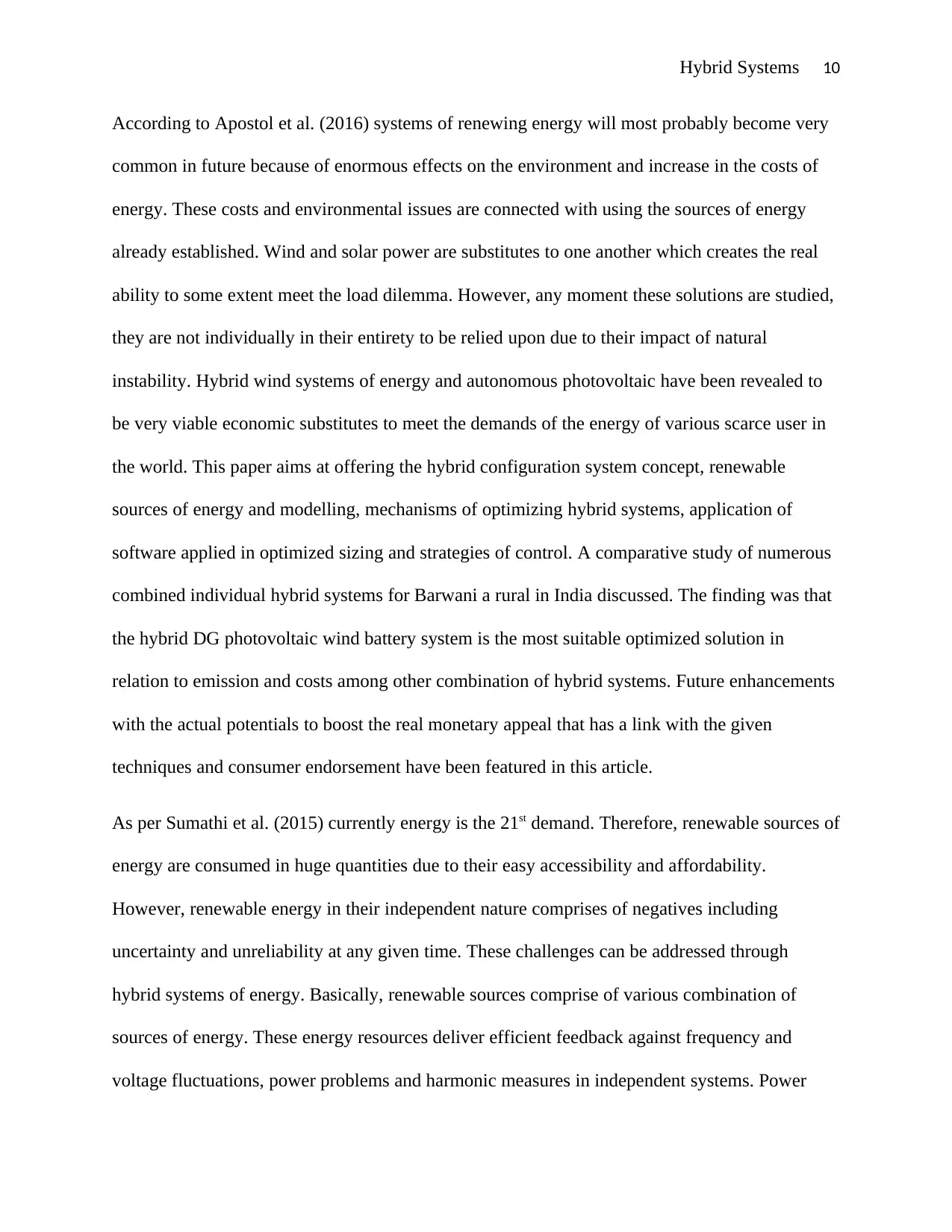
Hybrid Systems 10
According to Apostol et al. (2016) systems of renewing energy will most probably become very
common in future because of enormous effects on the environment and increase in the costs of
energy. These costs and environmental issues are connected with using the sources of energy
already established. Wind and solar power are substitutes to one another which creates the real
ability to some extent meet the load dilemma. However, any moment these solutions are studied,
they are not individually in their entirety to be relied upon due to their impact of natural
instability. Hybrid wind systems of energy and autonomous photovoltaic have been revealed to
be very viable economic substitutes to meet the demands of the energy of various scarce user in
the world. This paper aims at offering the hybrid configuration system concept, renewable
sources of energy and modelling, mechanisms of optimizing hybrid systems, application of
software applied in optimized sizing and strategies of control. A comparative study of numerous
combined individual hybrid systems for Barwani a rural in India discussed. The finding was that
the hybrid DG photovoltaic wind battery system is the most suitable optimized solution in
relation to emission and costs among other combination of hybrid systems. Future enhancements
with the actual potentials to boost the real monetary appeal that has a link with the given
techniques and consumer endorsement have been featured in this article.
As per Sumathi et al. (2015) currently energy is the 21st demand. Therefore, renewable sources of
energy are consumed in huge quantities due to their easy accessibility and affordability.
However, renewable energy in their independent nature comprises of negatives including
uncertainty and unreliability at any given time. These challenges can be addressed through
hybrid systems of energy. Basically, renewable sources comprise of various combination of
sources of energy. These energy resources deliver efficient feedback against frequency and
voltage fluctuations, power problems and harmonic measures in independent systems. Power
According to Apostol et al. (2016) systems of renewing energy will most probably become very
common in future because of enormous effects on the environment and increase in the costs of
energy. These costs and environmental issues are connected with using the sources of energy
already established. Wind and solar power are substitutes to one another which creates the real
ability to some extent meet the load dilemma. However, any moment these solutions are studied,
they are not individually in their entirety to be relied upon due to their impact of natural
instability. Hybrid wind systems of energy and autonomous photovoltaic have been revealed to
be very viable economic substitutes to meet the demands of the energy of various scarce user in
the world. This paper aims at offering the hybrid configuration system concept, renewable
sources of energy and modelling, mechanisms of optimizing hybrid systems, application of
software applied in optimized sizing and strategies of control. A comparative study of numerous
combined individual hybrid systems for Barwani a rural in India discussed. The finding was that
the hybrid DG photovoltaic wind battery system is the most suitable optimized solution in
relation to emission and costs among other combination of hybrid systems. Future enhancements
with the actual potentials to boost the real monetary appeal that has a link with the given
techniques and consumer endorsement have been featured in this article.
As per Sumathi et al. (2015) currently energy is the 21st demand. Therefore, renewable sources of
energy are consumed in huge quantities due to their easy accessibility and affordability.
However, renewable energy in their independent nature comprises of negatives including
uncertainty and unreliability at any given time. These challenges can be addressed through
hybrid systems of energy. Basically, renewable sources comprise of various combination of
sources of energy. These energy resources deliver efficient feedback against frequency and
voltage fluctuations, power problems and harmonic measures in independent systems. Power
Paraphrase This Document
Need a fresh take? Get an instant paraphrase of this document with our AI Paraphraser
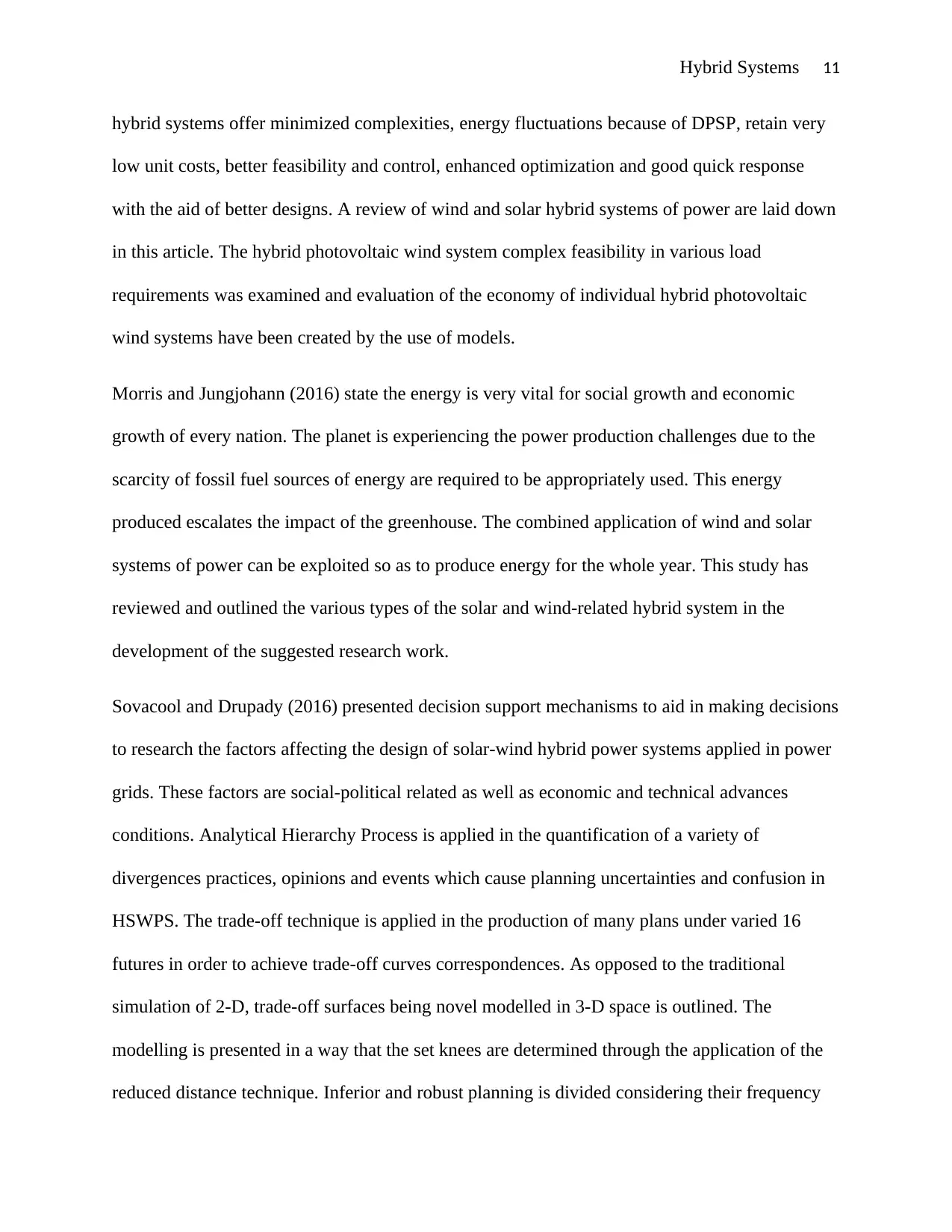
Hybrid Systems 11
hybrid systems offer minimized complexities, energy fluctuations because of DPSP, retain very
low unit costs, better feasibility and control, enhanced optimization and good quick response
with the aid of better designs. A review of wind and solar hybrid systems of power are laid down
in this article. The hybrid photovoltaic wind system complex feasibility in various load
requirements was examined and evaluation of the economy of individual hybrid photovoltaic
wind systems have been created by the use of models.
Morris and Jungjohann (2016) state the energy is very vital for social growth and economic
growth of every nation. The planet is experiencing the power production challenges due to the
scarcity of fossil fuel sources of energy are required to be appropriately used. This energy
produced escalates the impact of the greenhouse. The combined application of wind and solar
systems of power can be exploited so as to produce energy for the whole year. This study has
reviewed and outlined the various types of the solar and wind-related hybrid system in the
development of the suggested research work.
Sovacool and Drupady (2016) presented decision support mechanisms to aid in making decisions
to research the factors affecting the design of solar-wind hybrid power systems applied in power
grids. These factors are social-political related as well as economic and technical advances
conditions. Analytical Hierarchy Process is applied in the quantification of a variety of
divergences practices, opinions and events which cause planning uncertainties and confusion in
HSWPS. The trade-off technique is applied in the production of many plans under varied 16
futures in order to achieve trade-off curves correspondences. As opposed to the traditional
simulation of 2-D, trade-off surfaces being novel modelled in 3-D space is outlined. The
modelling is presented in a way that the set knees are determined through the application of the
reduced distance technique. Inferior and robust planning is divided considering their frequency
hybrid systems offer minimized complexities, energy fluctuations because of DPSP, retain very
low unit costs, better feasibility and control, enhanced optimization and good quick response
with the aid of better designs. A review of wind and solar hybrid systems of power are laid down
in this article. The hybrid photovoltaic wind system complex feasibility in various load
requirements was examined and evaluation of the economy of individual hybrid photovoltaic
wind systems have been created by the use of models.
Morris and Jungjohann (2016) state the energy is very vital for social growth and economic
growth of every nation. The planet is experiencing the power production challenges due to the
scarcity of fossil fuel sources of energy are required to be appropriately used. This energy
produced escalates the impact of the greenhouse. The combined application of wind and solar
systems of power can be exploited so as to produce energy for the whole year. This study has
reviewed and outlined the various types of the solar and wind-related hybrid system in the
development of the suggested research work.
Sovacool and Drupady (2016) presented decision support mechanisms to aid in making decisions
to research the factors affecting the design of solar-wind hybrid power systems applied in power
grids. These factors are social-political related as well as economic and technical advances
conditions. Analytical Hierarchy Process is applied in the quantification of a variety of
divergences practices, opinions and events which cause planning uncertainties and confusion in
HSWPS. The trade-off technique is applied in the production of many plans under varied 16
futures in order to achieve trade-off curves correspondences. As opposed to the traditional
simulation of 2-D, trade-off surfaces being novel modelled in 3-D space is outlined. The
modelling is presented in a way that the set knees are determined through the application of the
reduced distance technique. Inferior and robust planning is divided considering their frequency
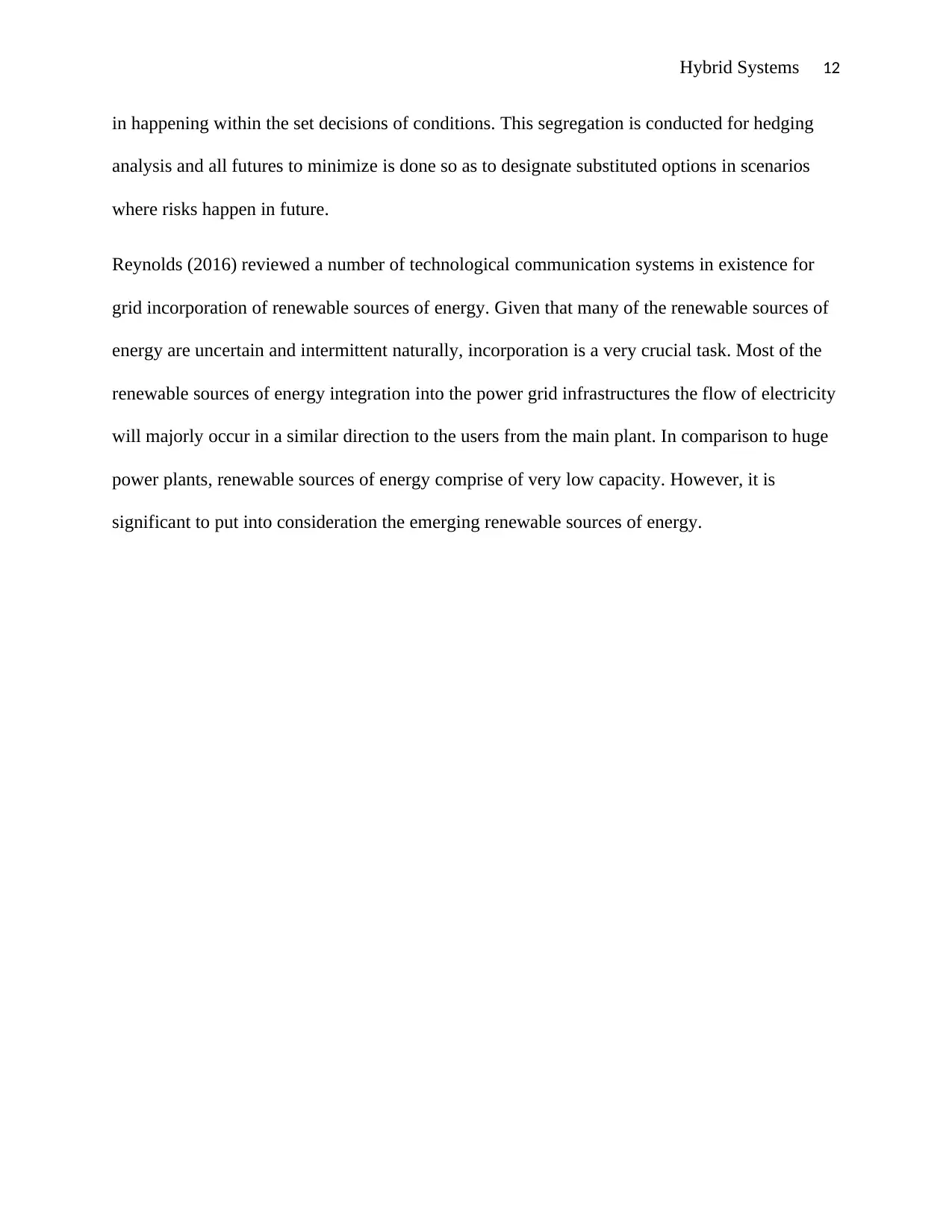
Hybrid Systems 12
in happening within the set decisions of conditions. This segregation is conducted for hedging
analysis and all futures to minimize is done so as to designate substituted options in scenarios
where risks happen in future.
Reynolds (2016) reviewed a number of technological communication systems in existence for
grid incorporation of renewable sources of energy. Given that many of the renewable sources of
energy are uncertain and intermittent naturally, incorporation is a very crucial task. Most of the
renewable sources of energy integration into the power grid infrastructures the flow of electricity
will majorly occur in a similar direction to the users from the main plant. In comparison to huge
power plants, renewable sources of energy comprise of very low capacity. However, it is
significant to put into consideration the emerging renewable sources of energy.
in happening within the set decisions of conditions. This segregation is conducted for hedging
analysis and all futures to minimize is done so as to designate substituted options in scenarios
where risks happen in future.
Reynolds (2016) reviewed a number of technological communication systems in existence for
grid incorporation of renewable sources of energy. Given that many of the renewable sources of
energy are uncertain and intermittent naturally, incorporation is a very crucial task. Most of the
renewable sources of energy integration into the power grid infrastructures the flow of electricity
will majorly occur in a similar direction to the users from the main plant. In comparison to huge
power plants, renewable sources of energy comprise of very low capacity. However, it is
significant to put into consideration the emerging renewable sources of energy.
⊘ This is a preview!⊘
Do you want full access?
Subscribe today to unlock all pages.

Trusted by 1+ million students worldwide
1 out of 42
Related Documents
Your All-in-One AI-Powered Toolkit for Academic Success.
+13062052269
info@desklib.com
Available 24*7 on WhatsApp / Email
![[object Object]](/_next/static/media/star-bottom.7253800d.svg)
Unlock your academic potential
Copyright © 2020–2025 A2Z Services. All Rights Reserved. Developed and managed by ZUCOL.




